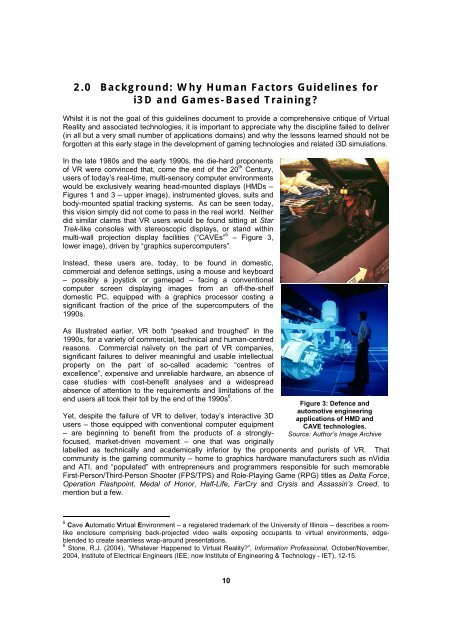Human Factors Guidelines for Interactive 3D and Games-Based ...
Human Factors Guidelines for Interactive 3D and Games-Based ...
Human Factors Guidelines for Interactive 3D and Games-Based ...
You also want an ePaper? Increase the reach of your titles
YUMPU automatically turns print PDFs into web optimized ePapers that Google loves.
2.0 Background: Why <strong>Human</strong> <strong>Factors</strong> <strong>Guidelines</strong> <strong>for</strong><br />
i<strong>3D</strong> <strong>and</strong> <strong>Games</strong>-<strong>Based</strong> Training?<br />
Whilst it is not the goal of this guidelines document to provide a comprehensive critique of Virtual<br />
Reality <strong>and</strong> associated technologies, it is important to appreciate why the discipline failed to deliver<br />
(in all but a very small number of applications domains) <strong>and</strong> why the lessons learned should not be<br />
<strong>for</strong>gotten at this early stage in the development of gaming technologies <strong>and</strong> related i<strong>3D</strong> simulations.<br />
In the late 1980s <strong>and</strong> the early 1990s, the die-hard proponents<br />
of VR were convinced that, come the end of the 20 th Century,<br />
users of today’s real-time, multi-sensory computer environments<br />
would be exclusively wearing head-mounted displays (HMDs –<br />
Figures 1 <strong>and</strong> 3 – upper image), instrumented gloves, suits <strong>and</strong><br />
body-mounted spatial tracking systems. As can be seen today,<br />
this vision simply did not come to pass in the real world. Neither<br />
did similar claims that VR users would be found sitting at Star<br />
Trek-like consoles with stereoscopic displays, or st<strong>and</strong> within<br />
multi-wall projection display facilities (“CAVEs” 5 – Figure 3,<br />
lower image), driven by “graphics supercomputers”.<br />
Instead, these users are, today, to be found in domestic,<br />
commercial <strong>and</strong> defence settings, using a mouse <strong>and</strong> keyboard<br />
– possibly a joystick or gamepad – facing a conventional<br />
computer screen displaying images from an off-the-shelf<br />
domestic PC, equipped with a graphics processor costing a<br />
significant fraction of the price of the supercomputers of the<br />
1990s.<br />
As illustrated earlier, VR both “peaked <strong>and</strong> troughed” in the<br />
1990s, <strong>for</strong> a variety of commercial, technical <strong>and</strong> human-centred<br />
reasons. Commercial naïvety on the part of VR companies,<br />
significant failures to deliver meaningful <strong>and</strong> usable intellectual<br />
property on the part of so-called academic “centres of<br />
excellence”, expensive <strong>and</strong> unreliable hardware, an absence of<br />
case studies with cost-benefit analyses <strong>and</strong> a widespread<br />
absence of attention to the requirements <strong>and</strong> limitations of the<br />
end users all took their toll by the end of the 1990s 6 .<br />
Yet, despite the failure of VR to deliver, today’s interactive <strong>3D</strong><br />
users – those equipped with conventional computer equipment<br />
– are beginning to benefit from the products of a stronglyfocused,<br />
market-driven movement – one that was originally<br />
10<br />
Figure 3: Defence <strong>and</strong><br />
automotive engineering<br />
applications of HMD <strong>and</strong><br />
CAVE technologies.<br />
Source: Author’s Image Archive<br />
labelled as technically <strong>and</strong> academically inferior by the proponents <strong>and</strong> purists of VR. That<br />
community is the gaming community – home to graphics hardware manufacturers such as nVidia<br />
<strong>and</strong> ATI, <strong>and</strong> “populated” with entrepreneurs <strong>and</strong> programmers responsible <strong>for</strong> such memorable<br />
First-Person/Third-Person Shooter (FPS/TPS) <strong>and</strong> Role-Playing Game (RPG) titles as Delta Force,<br />
Operation Flashpoint, Medal of Honor, Half-Life, FarCry <strong>and</strong> Crysis <strong>and</strong> Assassin’s Creed, to<br />
mention but a few.<br />
5 Cave Automatic Virtual Environment – a registered trademark of the University of Illinois – describes a roomlike<br />
enclosure comprising back-projected video walls exposing occupants to virtual environments, edgeblended<br />
to create seamless wrap-around presentations.<br />
6 Stone, R.J. (2004), “Whatever Happened to Virtual Reality?”, In<strong>for</strong>mation Professional, October/November,<br />
2004, Institute of Electrical Engineers (IEE; now Institute of Engineering & Technology - IET), 12-15.







![Benyamin Asadipour-Farsani [EngD Conference abstract]](https://img.yumpu.com/51622940/1/184x260/benyamin-asadipour-farsani-engd-conference-abstract.jpg?quality=85)









